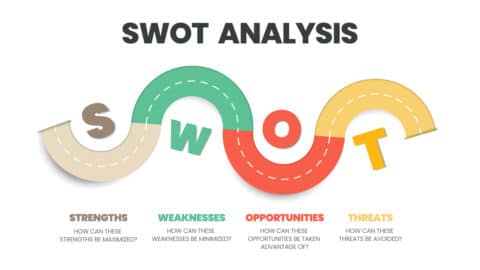In today’s competitive business landscape, it can be challenging to build a thriving company that is poised for long-term success. Many businesses must grapple with how to strike a balance between a growth mindset and a more stability-focused model. While growth and expansion are critical to remain competitive and establish yourself as an industry leader, this also exposes your business to a variety of financial risks that can threaten your long-term success, especially during times of economic uncertainty. Therefore, maintaining a sufficient level of stability is often valued as a way to navigate the economic downturns that inevitably occur over time.
Ideally, it’s important to blend both mindsets into an approach that embraces calculated growth. Businesses that are able to maintain core stability in their staff, operations and offerings while having the flexibility to more aggressively pursue strategic growth when opportunities arise are likely to set themselves up for long-term success. These businesses can more effectively navigate times of economic uncertainty while maintaining the levels of growth necessary to stay profitable year after year.
It can often be difficult to find the right balance between these two mindsets. Ultimately, there is no tried-and-true formula to navigate this decision. The right approach for your specific business will depend on a variety of factors associated with your company vision, the unique market dynamics impacting your industry, your business’ position within your market at the moment, and current economic conditions.
But in order to strike this balance, you first must understand the pros and cons associated with both an aggressive growth mindset and a stability-focused business model. Once you understand how these decisions will impact your business, there are also several steps you can take to determine the proper balance to achieve long-term success.
Pros and Cons of an Aggressive Growth Mentality

- Stronger market presence – Taking an aggressive approach to growth allows your business to gain a strong foothold in new market segments as they develop, giving you a competitive advantage over other businesses in your industry that move slower to leverage these opportunities.
- Attract new investors – Businesses that experience a strong growth trajectory are often able to attract new investors more easily. This can help generate significant funding opportunities and partnerships that will allow you to maintain your desired growth levels over the next few years.
- Foster innovation – Businesses that are faced with the pressure to meet aggressive growth goals will often need to innovate and diversify in order to achieve their goals. This can lead to breakthroughs that redefine your industry and help establish your company as a market leader.
However, taking an overly aggressive approach to business growth can also expose your business to significant risks. These include:
- Strain on company resources – Rapid growth typically requires an extensive investment in capital that can stretch your company’s resources thin. This can potentially have a negative impact on your ability to maintain superior product quality, deliver exceptional customer service and keep employee satisfaction levels high. It can also rob your business of an important financial safety net.
- Erosion of company culture – Aggressive growth can potentially result in an erosion of your company culture and core values. This can occur due to hiring new employees that aren’t a good fit for your culture and values, but it can also happen if your leadership team deviates from your established culture and values in order to prioritize growth goals that aren’t entirely aligned with your culture. This can cause a disconnect between leadership and employees that negatively impacts employee morale and leads to increased turnover.
- Vulnerability to economic uncertainty – Businesses that operate on a model predicated on rapid growth face greater risks in the event of an economic downturn. Sudden changes in consumer behavior in a tumultuous economic climate may not support the growth goals you’ve established, and with fewer resources available to navigate this economic uncertainty, your business may struggle to stay financially afloat.
Pros and Cons of a Stability-Focused Model

- Promotes sustainable growth – Prioritizing more calculated growth that fits within the parameters of your established business model can help you experience steady, moderate levels of growth that can be sustained over time. In addition, you’re less likely to experience the dips in quality that often occur when your resources are spread too thin. This approach makes it easier to avoid the types of quality issues that can tarnish your reputation and derail your long-term success.
- Resilience in times of uncertainty – Businesses that prioritize stability are often better equipped to navigate economic downturns, as they will have the solid financial foundation necessary to withstand leaner times.
- Attract the best talent – Many employees value stable work environments that offer opportunities for professional growth and development. When your business is able to provide this, you’re much more likely to successfully attract and retain the top talent in your field.
However, companies that over-emphasize stability without an eye towards significant growth potentially run the risk of stagnation due to:
- Lack of innovation – Stability-driven businesses are often averse to risk, and this might create a barrier to innovation. If this occurs, your business may become vulnerable to disruptions by more innovative competitors who are able to capture some of your market share as they introduce products and technology that surpasses your offering.
- Missed opportunities – Focusing too heavily on stability may make you hesitant to take an opportunistic approach when new trends develop in your industry. This can hinder your ability to maintain strong, sustained growth over time.
8 Critical Steps to Balance These Two Important Needs
If you’re looking to balance the desire to innovate and achieve aggressive growth goals with the need to maintain stability and sufficient cash flow, the following steps will help you establish a model that promotes long-term success and maintains optimal levels of profitability.
Assess Your Current Situation

In addition, you should also re-evaluate your company’s purpose, core values, mission and goals. Make sure your leadership team is truly aligned on these important items, because it’s critical that any strategic planning regarding the trajectory of your company stays true to your established culture and vision.
Develop a Strategic Plan
Once you have a clear understanding of your current situation and where you want to go, you can develop a strategic plan to help you get there. Keep in mind that the best strategic plans balance aspirational goals with a realistic assessment of both your company’s current standing as well as external forces that can potentially impact your success over time. This will allow you to find the right balance between growth and stability that will withstand the inevitable economic uncertainty that will occur from time to time.
When creating this plan, look at historic company data to see how previous economic downturns impacted your company, your industry and your customer base. This will provide the perspective necessary to understand the level of financial equity and flexibility you must maintain in order to navigate tough times, while maintaining the ability to get a little more aggressive and capitalize on opportunities you identify in the future.
Next, define your approach to growth. Consider the scope, speed and complexity of your desired growth. Assess the ways in which this growth will impact your team, your customers and your standing within your industry. In addition, make sure you understand the tradeoffs this approach will have on your effectiveness, efficiency and ability to innovate.
Define Your Success Indicators
You’ll need to manage your financial equity in a way that achieves your desired growth goals while allowing you to remain profitable and successful as economic conditions change and your business experiences growing pains. To do this, you’ll need to clearly define your success indicators as you implement your growth plan, as well as indicators that help you continuously evaluate your financial stability. Knowing these success indicators will help you assess where you are along your desired trajectory and what you need to do to get where you want to go.
Once you’ve clearly defined your success indicators, you’ll be able to make informed decisions about when to prioritize growth versus stability. While you’ve established a strategic plan, the reality is no plan ever goes exactly as you expect. There will inevitably be curveballs to navigate due to both internal and external factors. Tracking your success indicators will make it easier to devise creative ways to reach your goals and remain profitable while leveraging your resources in the most effective way possible.
Focus on Operational Efficiency

Some of the steps you can take to improve your efficiency include:
- Streamlining operations
- Improving supply chain management
- Investing in technology to automate processes
Pursue Sustainable Growth Opportunities
It’s always best to focus your efforts on pursuing sustainable growth opportunities that align with your long-term goals rather than opportunities that provide short-term gains, but may potentially compromise your stability. There are several ways to approach this:
- Explore growth opportunities that enhance your existing offering – Identify the needs of your target audience and focus your growth efforts on increasing the value your existing solutions provide to your customers. This strategy is often more profitable than continuously innovating just to stay ahead of your competitors, and it will help you maintain greater stability as you experience growth since you’ll be operating from a position of strength.
- Invest in innovation after reaching your profit goals – Innovation should never come at the expense of maintaining sufficient profit margins that will provide your business with the stability necessary to withstand unexpected challenges. Make sure you establish profit goals that provide your business with sufficient levels of stability. Once you reach these goals, invest the additional resources into initiatives that will help your company innovate and achieve greater growth.
- Limit the number of new ideas you pursue at once – Pursuing a wide range of innovations at once can overextend your business and spread your resources too thin. This can negatively impact the quality of your innovative new offerings, place a strain on your team that leads to frustration and burnout, and make it harder to maintain the levels of profitability necessary for stability. Instead, focus on one or two innovations that will move your company forward and help you achieve your desired growth goals.
- Manage the risks associated with growth – Growth opportunities will often place a strain on your resources. You may have to take on additional debt or experience short-term cash flow problems. In addition, you may experience operational challenges until you have the proper staffing levels to manage the additional workload associated with your growth. Make sure you mitigate these risks by maintaining healthy cash reserves, effectively managing debt and investing in the right areas.
Focus on Your Company’s Strengths and Core Values
Throughout this process, it’s important to ensure all growth and innovation is dictated by your company’s strengths and core values. While it’s important to continuously look for opportunities that develop as changes occur in your market and industry, you should always make sure you focus on opportunities that align with what you do well and that stay true to your values. This will ensure you’re able to deliver the value your customers desire, allowing you to build the loyal customer base necessary for long-term, sustainable growth.
Avoid getting caught up in all the latest trends, since this can potentially cause you to try and capitalize on every new development in your industry. This can have the opposite of your desired outcome – instead of helping you achieve steady, sustained growth that maintains your stability, it can cause you to become scattered and rudderless, which may potentially undermine your stability over time.
Before pursuing an emerging trend or a large growth opportunity, ask yourself if this approach is aligned with your company’s overall vision, goals and values. This will help you remain on the forefront of your industry in a strategic, purposeful way that also maintains the cash flow necessary to protect your company’s long-term financial stability.
Communicate with Your Team and Stakeholders

Your company culture is also critical to making this process successful. Make sure you foster a culture that embraces adaptability, patience, teamwork and communication. This will help you maintain stability among your team while your business goes through growth and change.
Monitor Your Plan and Adapt as Needed
As you’re implementing your company’s strategic growth plan, it’s important to continuously monitor the progress and outcomes using the success metrics defined at the start of the process. How well are you meeting your goals and expectations? How is your current growth trajectory impacting your employees’ performance and morale? Are you able to maintain sufficient cash flow and financial resources to achieve the stability necessary for long-term success?
This process will help you identify the successes achieved by your efforts as well as the challenges that may potentially threaten your long-term success. Based on this information, you can make any adjustments necessary to ensure your company remains on a path of sustainable, continued growth and success.
Webolutions’ Data-Driven Approach Can Help Your Business Grow and Thrive
As you implement your growth plan, it’s important to have the right strategic partners who can help you achieve your goals while maintaining the stability necessary for ongoing success. Webolutions has the expertise to help you grow and thrive.
We are the only strategic agency in the country delivering a transformational Intrinsic Multiplier™ Approach to grow your business faster, smarter and easier. This unique approach to marketing and strategic growth consulting is focused on evolving the mindset of your organization to deliver extreme marketplace success and highly relevant differentiation based on your core values, purpose, mission, specific set of strengths and unique culture.
We’ll collaborate with your team on a comprehensive planning process that will identify your short- and long-term growth goals, establish the proper success metrics to track, and determine the key steps necessary to achieve your goals. We’ll work with you to distill your unique company culture, purpose and core values to ensure this plan aligns with these important elements of your business and allows you to strike the right balance between growth and stability to remain successful.
At Webolutions, we believe in a data-driven approach to digital marketing and strategic growth implementation. Our team will set up the tracking necessary to compile the data you need to measure your success, and we’ll set up performance intelligence dashboards that make it easy for you to view this data and determine the proper adjustments to make as you’re executing your plan. This comprehensive, data-driven process will help you achieve sustainable growth while maintaining the ability to withstand any economic uncertainty that may arise down the road.
Contact us today to schedule a free consultation. Webolutions serves clients nationwide from our offices in Denver, Colorado.

